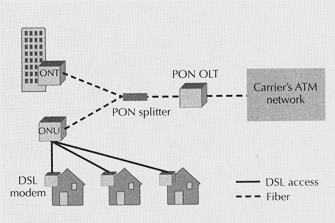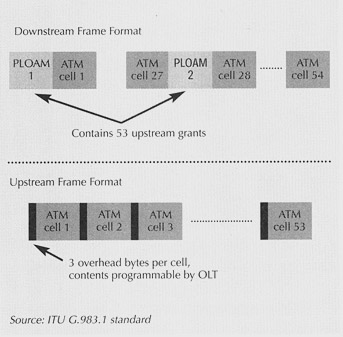Passive Optical Networks
| |
When it comes to last-mile access, network operators must choose between their favoriteswill it be low cost, long range, high performance, or rapid deployment? Choose DSL or cable-modem access and they gain the benefits of installed infrastructure, but sacrifice range and multimegabit performance. Go with fixed wireless and they sacrifice performance or distance.
Passive Optical Networks (PONs) offer an alternative. By eliminating regenerators and active equipment normally used in fiber runs, PONs reduce the deployment and installation costs of fiber. Those costs still require laying fibermaking PONs far more expensive than DSLbut the potential performance gain and long- term prospects make PONs well-suited for new neighborhoods or installations.
PONs may never knock down consumer doors, but that doesn't mean the technology won't appear in existing neighborhoods. PONs are a strong complement to enabling Very High Data Digital Subscriber Line (VDSL). Today, VDSL modems can reach 52Mbit/sec over 300 meters . PONs enable carriers to extend that distance by only running VDSL to the customer premises, and then going over fiber back to the Central Office (CO). What's more, a PON's use of ATMthe protocol favored by DSL simplifies the interconnection of the two technologies. Finally, new QoS and fault tolerant features add critical technologies needed to deliver real-time video streaming, an often talked about application for VDSL.
A PON, or an Optical Access Network (OAN), is a tree-like structure consisting of several branches, called Optical Distribution Networks (ODNs). The ODNs run from the CO to the customer premises using a mix of passive branching components , passive optical attenuators, and splices.
Three active devices can be used in a PON. At the CO, carriers install a special switch, called an Optical Line Terminal (OLT), which either generates light signals on its own or takes in SONET signals (such as OC-12) from a colocated SONET cross-connect. The OLT then broadcasts this traffic through one or more outgoing subscriber ports. Depending on where the fiber terminates, either an Optical Network Unit (ONU) or an Optical Network Termination (ONT) receives the optical signal and converts it into an electrical signal for use in the customer premises. (ONTs are used when the fiber extends into the customer premise , whereas ONUs are used when fiber is terminated outside of the home.) DSL then brings the signal to the customer premises (see Figure 1).

Figure 1: PONs consist of four key elements: An OLT sits in the central office controlling the PON network. Splitters sit at various fiber junctions dividing the signal into multiple channels. ONU or ONTs terminate the signals at or just before the customer premises.
WDM, TDM, And ATM
PONs use a combination of an access protocol, either ATM or increasingly Gigabit Ethernet, Wavelength Division Multiplexing (WDM), and Time Division Multiplexing (TDM). ATM-based PONs (APONs) work like big ATM networks. Customers establish Virtual Circuits (VCs) across the APON to a destination, such as another office or the ISP's premises. These VCs are bundled into what's known as Virtual Paths (VPaths) for faster switching in the carrier's network. The IEEE is just now standardizing Ethernet-based PON (EPON).
The speed of operation depends on whether the APON is symmetrical or asymmetrical. Symmetrical APONs operate at OC-3 speeds (155.52Mbit/sec). For Asymmetrical APONs, the downstream transmission from the OLT in the CO to the customer premises ranges from 155.52 to 622.08Mbit/sec. Upstream transmission from the customer premises to the CO occurs at 155.52Mbit/sec. All network topologies support both configurations, unless the fiber extends to the home, in which case asymmetrical operation isn't supported.
The upstream and downstream transmissions occur over two channels, which can be different wavelengths on the same cable or two different cables. The original APON specification called for downstream transmission on a single fiber occuring between 1,480 and 1,580 nanometers (nm); on dual fibers, between 1,260nm and 1,360nm. Upstream transmissions always occur between 1,260nm and 1,360nm.
A new ITU standard adds Wide WDM (WWDM) capabilities to APONs. With the specification, downstream transmission is split into two bands: regular transmissions range from 1,480nm to 1,500nm, and a new enhanced band for future applications (such as video services) occurs at 1,539nm and 1,565nm. APONs can now support 16 wavelengths (with 200GHz spacing between channels) or 32 wavelengths (with 100GHz spacing between channels). However, since customers need one wavelength for transmission and another for receiving, these numbers are effectively cut in half.
If there's bad news, it's that implementing these new channels will require expensive equipment. Since the new spectrum is narrower, there's less allowable drift in the laser. Therefore, PON equipment delivering WWDM will likely need more expensive lasers. Across the main band from 1,480nm to 1,500nm, PONs run a TDM architecture across the send and receive channels. Within these time slots, the network behaves like a LAN, implementing Ethernet or ATM.
The OLT regulates network access with a complex frame structure. The upstream and downstream channels are divided into frames and time slots. The exact size of each depends on the configuration. Within a symmetrical network, for example, downstream frames consist of 56 time slots54 for data and two for management information. Each time slot is equal to an ATM cell, or 53 bytes. Upstream frames are 53 time slots long, but run 56 bytes each. The additional three bytes are overhead which the OLT can program for various purposes, such as requesting an ONU to transmit a Physical Layer Operations and Maintenance (PLOAM) cell or a minislot to gather management information (see Figure 2). Asymmetrical APONs use frame time slot configurations that are four times greater on the downstream to accommodate the 622Mbit/sec speeds.

Figure 2: PONs use a complex frame structure for relegating access to the network.
The APON specification uses two types of cells. Data cells carry information including user data, signaling information, and Operations and Management (OAM) information. The second, PLOAM cells , pass physical infrastructure information around the network. They also carry grants, codes supplied by the OLT that allow access to the network. OLTs can also divide up the time slot into minislots to gather information about the ONUs' traffic queues in order to implement QoS or Dynamic Bandwidth Allocation (DBA).
PON Workings
One benefit of APONs is that the system automatically detects new devices. Periodically, the OLT creates a gap in the upstream time slots of a few hundred microseconds and sends a special permission, a ranging grant, which anyone can answer. A new ONT will see the ranging grant and respond with its unique serial number. The OLT receives this number and configures the ONT with the information needed to join the APON. This information includes an APON ID and two kinds of grantsa PLOAM grant and a data grant, which is used to access the network.
Then ATM kicks in. When the OLT sends an ATM cell down the APON, each ONT compares the cell's VPath identifier against its own. If there's a match, the ONT copies the cell, removes it from the network, and sends it to the customer premises. Each customer premises then compares the cell's VC identifier against its own, and if there's a match, the node copies the data and removes the cell.
When an ONT needs to send information, it waits for the OLT to send a PLOAM cell. Each PLOAM cell has 26 or 27 grants that anyone can read. The ONT checks the data grant number in the PLOAM cell, and when it matches its own, the ONT uses the grants to send the data. The cell is then transmitted upstream. The OLT receiver receives the bits and, using the preamble to recover the clock, reads out the cells and passes them to the ATM switch for delivery onto the provider's metro core network.
Security And QoS
Security and QoS have been hot areas in APONs. APON security is tricky because any ONT can read any cell. Like the voice network, there's no inherent security mechanism to prevent intrusion.
However, the current APON specification does provide some rudimentary form of security, called scrambling . Each cell's payload runs through encryption algorithms that mix up (or "scrambles") the data using a 24-bit encryption key. The shortness of the encryption key makes it very weak (even 40-bit keys are considered weak), but changing the encryption key's key on the fly improves the security somewhat.
As for QoS, while ATM enables different types of circuits, the current APON specification doesn't. Each traffic flow is treated equally. A new ITU standard will add DBA to APONs. DBA will allow the OLT to determine who has the data, and adjust the number of grants sent accordingly .
OLT will accomplish this by sending a minislot grant. The ONT will reply with the queue information, indicating the number of cells to be transmitted. The OLT will then measure the amount of data to be sent against the type of service the customer purchased, existing traffic conditions, and so on. Based on this information, the OLT will then issue a grant, and the ONT will respond in the normal manner.
Management And Survivability
Public networks aim for reliability above all. Forget the increased performance, enhanced security, and improved QoS that PONs can offer. Without adequate uptime, no service will be in business for long, so providing adequate management and fault tolerance is crucial.
With APONs, the PLOAM cells supply the management. They allow ONTs to report back to the OLT about themselves . The same cells also provide certain bit patterns that can align lasers and measure power output.
For fault tolerance, an emerging APON specification will enable redundancy in the network. The APON will work similar to SONET's dual-ring configuration: Each ONT will connect to two OLTs. Two protection scenarios are then possible. One-to-one protection lets the transmitter choose which line to use, leaving the other untouched. Providers could use this configuration to put Unspecified Bit Rate (UBR) traffic on the backup line, with the understanding that a failure could cause the traffic to be bumped from the network.
The second approach is called one-plus-one protection, in which transmitters and receivers on both sides of the network pick the cleaner line to communicate over. Therefore, in the event of a switch-over, no traffic is lost from the backup line.
Resources
To catch up on the details of the Passive Optical Network (PON) spec, visit www.itu.org and download the PON standard, g.983.1.
You can find the Full Service Access Network (FSAN) organization at www.fsanet.net.
There are plenty of articles on PONS in Network Magazine , including "PON Progress Report: Operating on RBOC Time" (June 2001, page 68, www.networkmagazine.com/article/NMG20010518S0008) and "Passive Optical Networks in Action" (November 2000, page 124, www.networkmagazine.com/article/NMG20001103S0008).
Additional detail on the PON specification and other optical network technologies can be found in The Essential Guide to Optical Networking written by this author.
This tutorial, number 161, by David Greenfield, was originally published in the December 2001 issue of Network Magazine.
| |
EAN: 2147483647
Pages: 193